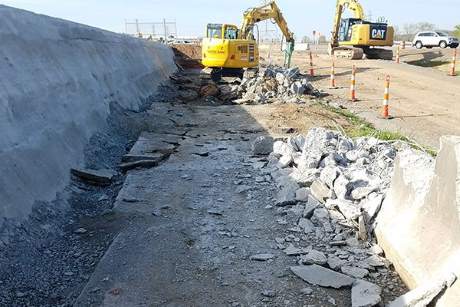The Tennessee Valley Authority (TVA) has completed a multi-year series of major construction works to protect the Sequoyah and Watts Bar nuclear plants from the most extreme of weather events. The final project, a new seven-foot (2.1 metre) high concrete flood wall at Fort Loudoun Dam, would hold back the waters of the Tennessee River in the event of an extreme flood.
 |
| Fort Loudoun's new flood wall will protect two nuclear power plants in worst-case scenario flooding. The old flood protection wall is being demolished. (Image: TVA) |
Over 1200 feet in length, the Fort Loudoun wall is four feet higher than the wall it replaces. Work at Fort Loudoun has also included construction of a 1400 feet long rolled compacted concrete section of the dam's south embankment and modification of another section of the dam with post-tension anchors and steel bar reinforcement.
TVA in 2009 decided to modify five dams - Cherokee, Douglas, Fort Loudoun, Tellico and Watts Bar - to provide extra protection for nuclear plants in the event of worst-case scenario flooding known as a probable maximum flood. Such an extreme flood has never occurred and is highly unlikely, TVA said.
TVA's Dam Safety, River Management and Nuclear Generation Construction & Project organisations worked together to calculate possible flood levels, determine modifications needed to protect nuclear power plants in a probable maximum flood, carry out field investigations and analyses and complete the dam modifications.
Initial modifications involved temporary barriers, made by stacking wire-mesh containers filled with sand, to raise the flood wall height. These were then replaced with permanent concrete flood walls or earthen embankments. The final temporary barriers have now been removed from Loudoun Dam. Sand from the discarded temporary barriers has been re-used to maintain walkways, trails and in other work at TVA sites.
Husein Hasan, TVA senior programme manager for dam safety, said the teamwork, collaboration and expertise of the various groups involved in the long-term project have been "remarkable".
"Completion [of the modifications] at Fort Loudoun is a major achievement that will greatly increase the safety and reliable operations of our dams and nuclear plants in the event of the most extreme adverse weather conditions," he said.
Sam Vinson, TVA principal project manager, said the company had made a commitment to the Nuclear Regulatory Commission to have the permanent flood walls and other work completed by June this year.
"With completion of this work at Fort Loudoun, TVA has met and exceeded that goal," Vinson said.
TVA's Tennessee nuclear power plants - two units at Sequoyah and two at Watts Bar - together provide over 4600 MWe of generating capacity.
Fort Loudoun Dam, on the Tennessee River near Lenoir City, was built by TVA in the 1940s. The reservoir is connected by a short canal to the Tellico Reservoir, jointly providing flood damage reduction, power production, recreation and navigation. The dam's four hydroelectric generating units have a net dependable capacity - the amount of power the dam can produce on an average day, minus the electricity used by the dam itself - of 162 MWe.
The previous Fort Loudoun flood wall, which was built in 1989, is being demolished.
Researched and written
by World Nuclear News




_47120.jpg)

_23621.jpg)






